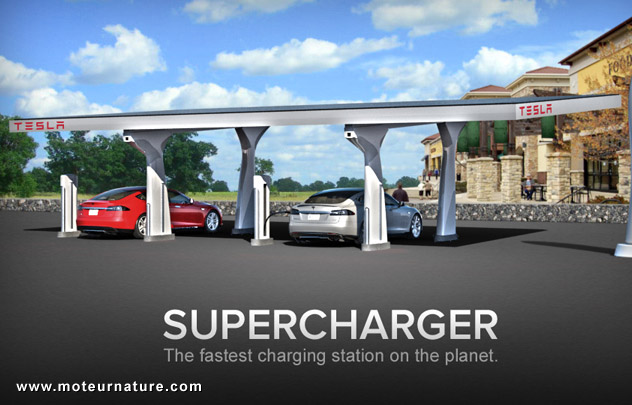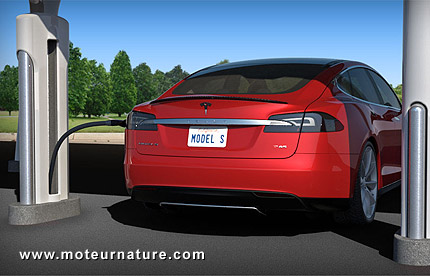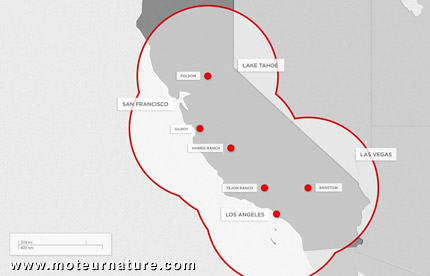
 A solar charging station for EVs is a cool idea, though it’s not new. GM opened one to recharge some Volt plug-in hybrids in Michigan. Tesla wanted to do it better, and it invented the superfast solar charging station. It puts out a 100 kW current! That’s strong enough to charge two thirds of the big battery of a model S in only 30 minutes. Imagine that a Nissan Leaf, if it could accept such a current, would recharge in less than a quarter of an hour. Sadly, it’s unrealistic it will ever be. You just need a very large battery to absorb such a current without overheating. Therefore, the superfast charging stations will only be accessible to model S owners, even the roadsters from the same manufacturer would not to be able to plug there. Or maybe at a slower rate, and a adapter would be required since the model S has a proprietary connector.
A solar charging station for EVs is a cool idea, though it’s not new. GM opened one to recharge some Volt plug-in hybrids in Michigan. Tesla wanted to do it better, and it invented the superfast solar charging station. It puts out a 100 kW current! That’s strong enough to charge two thirds of the big battery of a model S in only 30 minutes. Imagine that a Nissan Leaf, if it could accept such a current, would recharge in less than a quarter of an hour. Sadly, it’s unrealistic it will ever be. You just need a very large battery to absorb such a current without overheating. Therefore, the superfast charging stations will only be accessible to model S owners, even the roadsters from the same manufacturer would not to be able to plug there. Or maybe at a slower rate, and a adapter would be required since the model S has a proprietary connector.
4 of those superfast charging stations have already opened in California. There will be 2 more in a few days, and the plan is to have 100 all over the continental US. Strangely, Tesla Motors doesn’t reveal any characteristics about its “supercharger” stations. All it says is that the energy produced by the solar cells will be higher than the energy used by all the cars charging. Let’s try a little math.
 20 cars charging per day with an average charge of 50 kWh (battery capacity of the model S is 85 kWh). At the end of the year, that makes 20x50x365 or 365,000 kWh. This will require hundreds of solar panels, and make for very expensive charging stations. Elon Musk said the budget for 100 stations will be between $20 to 30 millions. That is a rather low estimate in my eyes, which obviously doesn’t include property. And don’t forget that the cost of a solar charging station in Chicago will be much higher than in Dallas. The big question is who will pay for this investment because Musk said that charging will be free to all model S owners. Forever! It will be possible to drive cross-country without spending a dime. That’s what Elon Musk said!
20 cars charging per day with an average charge of 50 kWh (battery capacity of the model S is 85 kWh). At the end of the year, that makes 20x50x365 or 365,000 kWh. This will require hundreds of solar panels, and make for very expensive charging stations. Elon Musk said the budget for 100 stations will be between $20 to 30 millions. That is a rather low estimate in my eyes, which obviously doesn’t include property. And don’t forget that the cost of a solar charging station in Chicago will be much higher than in Dallas. The big question is who will pay for this investment because Musk said that charging will be free to all model S owners. Forever! It will be possible to drive cross-country without spending a dime. That’s what Elon Musk said!
His idea is that the construction and maintenance cost of all charging stations will be entirely supported by Tesla Motors. How can it be possible, you may ask. How come a small company like Tesla Motors afford such a project? Well, it can’t. Tesla Motors will have one more time to raise more money to fund its plans. So anyway you look at it, this is crazy. The purpose of a business is normally to make money, but Tesla Motors has been losing money every quarter since it started in 2003. Now, for the first time, the opportunity to become a profitable company was on the horizon with the launch of the model S, but Tesla is choosing one more time its increase its spendings before its revenues. One can seriously doubt Tesla Motors will ever be a profitable company. It doesn’t show any sign it wants it. Is this sustainable?
There’s hardly any maintenance on solar panels. It can be done remotely.
You ask: is this sustainable? I think it is, but in an unexpected way.
In the US electric cars have been permanently ridiculed in the press. Most of the arguments were wrong, but it has caused that the broader public is sceptical, to say the least. So if you want to sell electric cars and make a profit you have to do more then make a good car. You have to break through this layer of wrong perceptions. For that you need something bold and Elon Musk understands that.
The only way to turn a profit is by volume. And for volume you need a lot of potential clients. The supercharchers are a way to wow potential clients, to definitely break through the last eternal bad publicity: that of limited range. Now, with the superchargers, a Tesla S is not only as good a driving experience as a BMW series 5 (and some say better), as fast or faster, for the same price, but you can do the same things with it, including business or holiday trips, but without polluting. And for free if you use the superchargers.
This is publicity. This takes away the last barrier. This makes people rave about Tesla like they do about iPhones. This is what opens up the road to high volume. And therefore to profit.
Tesla always had a long timescale philosophy. Prices of solar panels are falling fast. And Musk’s other company – SolarCity – can built the solar part of the stations at nearly cost price. And finally Tesla is itself a sophisticated battery company, so they can built the huge batteries/chargers themselves. Therefore the costs are lower then you would expect. And don’t forget the panels produce more electricity then used by the charging cars, so Tesla (or SolarCity) sells the rest into the grid. And for the early years, with few Tesla’s charging, actually most of the electricity will flow into the grid and generates some income, lowering the costs.
The superchargers don’t eat away as much profits as one might think, while they boost the image of Tesla cars, bringing volume sales at last. So Tesla’s philosophy is sustainable.
Well, maybe it will, but at this time it is not.
I will have my first look at a production model S tomorrow, but at this time, I have no reason to think it’s a better car than a base model BMW series 5. A BMW 525d has a 700 miles range, a 150 mph top speed, and it’s half the price of the Tesla, so I don’t see anyone in Europe having any hesitation between the 2.
A quick guess is that Tesla is expecting to pay zero for space. They will use parking lot space by agreement with a restaurant. The restaurant gets an extra flow of high purchasing power individuals, who will take up a parking spot, as they would anyway.
So, if Tesla pays nothing for space, and nothing net for electricity, the scheme has only administrative, maintenance, and capital costs. The capital cost is built in to the cost of each Model S with Supercharger, maintenance would be drawn from the service contract income, and administrative should be very low because the service is free, so no need to track and invoice every charge.
The only crazy element about this whole scheme is the ridiculous alien looking superdildo sign Musk unveiled. My guess is that it will never be deployed in quantity, if at all, with that form. None of the actual charging stations actually have it at this point, and Tesla owners will find the Superchargers through navigation, not by looking out for the giant phalus.
But it’s viable, for sure.
I haven’t seen the Tesla model S, it wasn’t in Paris. Not sure why, Tesla was there last time. I guess they had some positive reviews from the American press, so they don’t want to risk everything with negative comments from much more demanding European journalists. In Geneva, they were people running away laughing after seeing the terrible quality of the car which was there…
Back to the subject, the scheme needs long lasting arrangements since solar cells only pay for themselves after many years. I doubt agreements with restaurants would qualify. And when it comes to capital costs, it’s difficult to imagine the margin on the cars are so fat they would allow this. We’ll see…